#Pseudosuchians
Text

Postosuchus
108 notes
·
View notes
Text

Whelp we’ve got about a week and a half til November (aaaaaah), so I guess I’ll post this year’s Archovember list now!
It’s a bit dinosaur-heavy this time, but there are a lot of species I’d really like to try my hand at! Also, we have two leptoceratopsians and two Araripesuchus species. I thought it would be interesting to compare and contrast these species within the same month, so I hope it doesn’t get /too/ repetitive!
For new folks: this is my “Draw Dinovember” list that I expanded out to include other archosauriforms. I started doing this a few years ago to challenge myself to draw species I’ve never drawn before and/or ones that don’t get a lot of attention. Feel free to join in! You can do the whole list, just the dinosaurs, just the pterosaurs, just the pseudosuchians, just your favorites, just ones you’ve never drawn before, roll a D20 and a D10 and draw the sum of whichever numbers you get, etc. Just make sure they’re posted on or after their specific day so I remember to share them on my blog! You can use #Archovember or #Archovember2023, as those are the tags I follow. (Note that I and the whole Archovember event are usually a lot more active on Instagram so if you have an IG I encourage you to join in there!)
Anyway, here is the list in case the graphic is hard to read:
1. Your Choice!
2. Furcatoceratops elucidans
3. Tupandactylus navigans
4. Deinosuchus hatcheri
5. Herrerasaurus ischigualastensis
6. Lewisuchus admixtus
7. Supersaurus vivianae
8. Zhejiangopterus linhaiensis
9. Dynamosuchus collisensis
10. Megalosaurus bucklandii
11. Macrospondylus bollensis
12. Miragaia longicollum
13. Dorygnathus banthensis
14. Leptoceratops gracilis
15. Stagonolepis robertsoni
16. Shantungosaurus giganteus
17. Paleorhinus bransoni
18. Cascocauda rong
19. Kelenken guillermoi
20. Prestosuchus chiniquensis
21. Yangchuanosaurus shangyouensis
22. Istiodactylus latidens
23. Kunbarrasaurus ieversi
24. Araripesuchus wegeneri
25. Tylocephale gilmorei
26. Ixalerpeton polesinensis
27. Udanoceratops tschizhovi
28. Tapejara wellnhoferi
29. Araripesuchus rattoides
30. Scutellosaurus lawleri
One last note, and a warning I usually issue to new paleoartists: while looking for references for these species you’ll come across David Peters. His references tend to dominate search results when looking for less well-known species. They are also highly inaccurate, even the skeletals. So make sure you omit “The Pterosaur Heresies” and “Reptile Evolution” from your google search. If you have issues finding references, let me know and I can share what I’m using!
#my art#Archovember#Archovember2023#SaritaDrawsPalaeo#dinosaurs#pterosaurs#pseudosuchians#archosaurs#archosauriforms
56 notes
·
View notes
Note
I can't be the only one who was always devastated when Postosuchus died in that first episode of Walking With Dinosaurs, right?
Yeah it was sad :(
30 notes
·
View notes
Text
Dinofact #53
The largest carnivorous archosaur of late Triassic central Europe, Smok wawelski may be a rauisuchid (large predatory Triassic archosaur), prestosuchid (active terrestrial Triassic apex predator), ornithosuchid pseudosuchian (distant relative of crocodilians), or a primitive theropod dinosaur. However, its relation to other archosaurs has not been thoroughly studied, so its status as dinosaur, crocodile, or other remains a mystery.
Source: wikipedia
#dinosaur#dinosaurs#paleontology#smok#smok wawelski#rauisuchid#rauisuchids#rauisuchidae#prestosuchid#prestosuchids#prestosuchidae#ornithosuchid#ornithosuchids#ornithosuchidae#pseudosuchian#pseudosuchia#pseudosuchians#theropod#theropods#theropoda#fun facts#trivia#dinosaur trivia#dinosaur fun facts#16th#october#2022#october 16th#october 2022#october 16th 2022
92 notes
·
View notes
Text
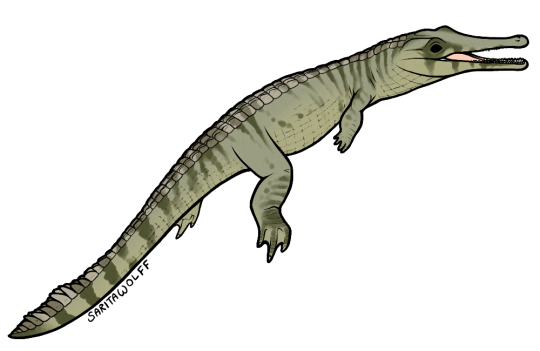
Patreon request for @/rome.and.stuff (Instagram handle) - Turnersuchus hingleyae
Described just last year, the Early Jurassic Turnersuchus is the most basal known member of the thalattosuchians: sea-dwelling crocodylomorphs. It existed before the two major thalattosuchian groups, the paddle-limbed Metriorhynchoidea and the long-snouted Teleosauroidea, split, and it may be the ancestor of both. While only parts of the skull are known, its shape suggests a narrow snout that was not as long as that of later thalattosuchians. Only one osteoderm is known, and it is oval with a slight keel down the middle, believed to have been attached to the tail. As humble as this small pseudosuchian was, it helped us fill in the major gaps of our understanding of thalattosuchia, and finally gave us an idea of their origin. Previously, all we knew was that the highly-derived metriorhynchoids and the more crocodile-like teleosauroids were related, lived alongside each other, and seemingly appeared in the Jurassic. While not as well known as the icthyosaurs, plesiosaurs, and mosasaurs, thalattosuchians were very successful sea crocodylomorphs until around the Early Cretaceous, and they owe their success to this little pseudosuchian who decided to return to the sea.
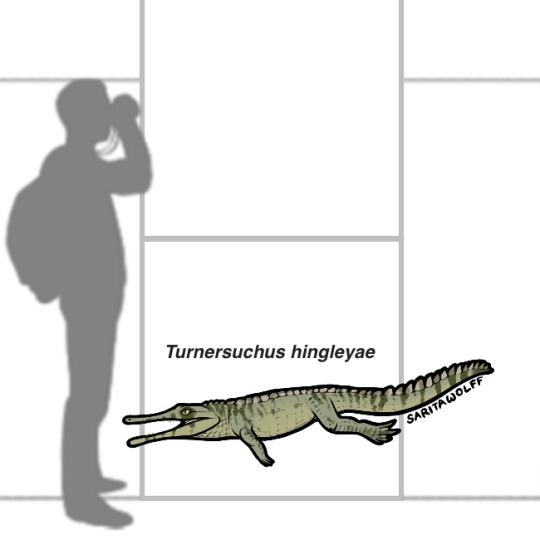
Found in the Charmouth Mudstone Formation of England, Turnersuchus would have lived alongside a variety of ammonites like Phricodoceras and Gemmellaroceras, as well as icthyosaurs like Leptonectes. It likely fed on the small fish that lived here. As it was not as highly adapted for ocean life as its descendants, it may have spent some time basking on land, where it could have come across early dimorphodontid pterosaurs and the armored Scelidosaurus.
#my art#Turnersuchus hingleyae#Turnersuchus#Thalattosuchians#crocodylomorphs#pseudosuchians#archosaurs#archosauromorphs#reptiles#SaritaDrawsPalaeo#Charmouth Mudstone Formation#Early Jurassic#England
2 notes
·
View notes
Text



A good boi.
5K notes
·
View notes
Video
youtube
1 note
·
View note
Text
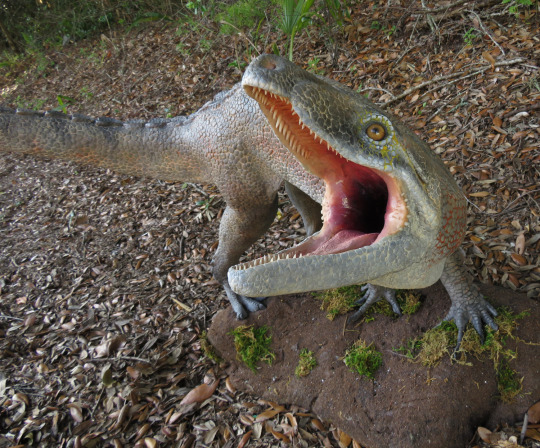

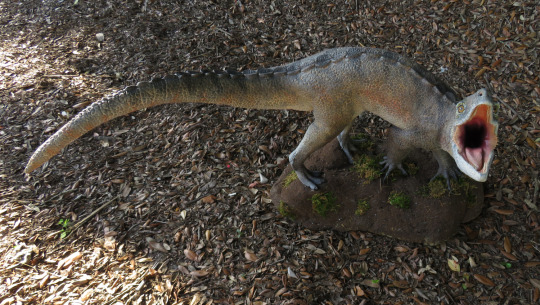
Hesperosuchus would like a bit more personal space
#sculpture#paleoart#crocodyliforme#hesperosuchus#pseudosuchians are just the cutest#I hope it's clear this is a terrified little critter and not an aggressive one
318 notes
·
View notes
Text
Paleostream 24/02/2024
here are this week's #Paleostream drawings!
today we drew Megalosaurus, Stegotetrabelodon, Prestosucus, and Plotosaurus
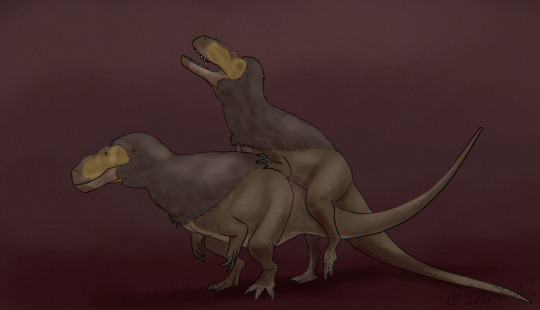

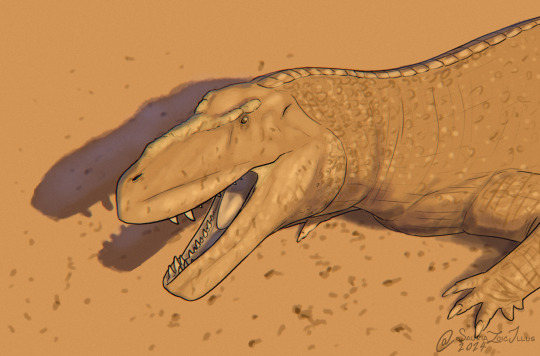

#paleostream#paleoart#paleontology#digital art#artists on tumblr#digital artwork#palaeoart#digital illustration#id in alt text#sciart#dinosaur#palaeoblr#paleo art#Megalosaurus#Stegotetrabelodon#Prestosuchus#Plotosaurus#mosasaur#elephant#pseudosuchian
160 notes
·
View notes
Text
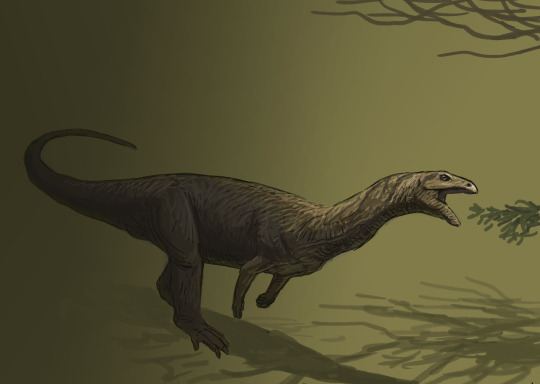



Results from the #paleostream Sillosuchus, Suchomimus, Shuvosaurus and Fukuivenator.
#sciart#paleoart#paleostream#palaeoblr#cretaceous#dinosaur#dinosaurs#triassic#poposaur#pseudosuchian
327 notes
·
View notes
Text


A very experimental Prestosuchus drawing, using a lot of brushes that ive not used before.
131 notes
·
View notes
Text
[ Presto ]
" With an impressive speed & attack stat, Presto can help those wanting swift victories. "
33 notes
·
View notes
Text

#Archovember Day 4 - Deinosuchus hatcheri
I have long had little to no interest in drawing Deinosuchus as it’s simply “a big alligator” with, in my opinion, nothing interesting or unique about it anatomically. But I get people asking about it at least once a year, so I finally added it to an Archovember list. And it wasn’t until drawing this thing’s size chart that I realized how large and terrifying this animal would have been. It was truly an apex predator.

Deinosuchus lived during the Late Cretaceous across most of the USA and Northern Mexico, on both sides of the Western Interior Seaway, growing to larger sizes on the Western side but with a more abundant population on the Eastern side. It was an alligatoroid, closely related to modern alligatoroids like alligators and caimans (though not a direct ancestor), and would have looked similar to its smaller relatives. One study indicated that Deinosuchus had a growth rate similar to modern alligators, taking over 35 years to reach adult size, but as it had a lifespan of up to 50 years it had the time to grow so large… up to 10.6 meters (35 ft) long. Unusually large and heavy osteoderms held by connective tissue would have served as load-bearing reinforcement, allowing Deinosuchus to support its bulky frame on land as well as in water. Its teeth were adapted for crushing, not piercing, and with an estimated bite force of 18,000 N (1,835 kgf; 4,047 lbf) to 102,803 N (10,483 kgf; 23,111 lbf) it likely would have clamped down and held its prey underwater til it drowned, similar to modern crocodilians. A 2014 study suggested that they also would have been able to “death roll”, spinning their massive body in the water to tear off chunks of flesh.

As an apex predator and an alligatoroid, Deinosuchus would have fed on whatever it could have caught, including fish, sea turtles, and dinosaurs. Depending on where in the US it lived, Deinosuchus’ diet would have varied. The smaller-bodied Eastern population likely had a niche similar to American Alligators, opportunistically feeding on large fish, marine turtles, and smaller dinosaurs. Meanwhile, the larger-bodied Western population would have been more specialized in ambushing large dinosaurs. However, there were no large theropod dinosaurs in Deinosuchus’ eastern range (that we know of) so even as a smaller “terrible crocodile” it would have been the apex predator of the region.
#my art#SaritaDrawsPalaeo#Deinosuchus hatcheri#Deinosuchus#crocodilian#pseudosuchians#archosaurs#archosauromorphs#reptiles#Archovember#Archovember2023
22 notes
·
View notes
Note
Do you think mesothermy (or even full endothermy) is plausible for Sebecids?
So bone histology has been done on Iberosuchus, but it didn't indicate endothermy. That said, it had a more regular growth pattern than ectothermic lizards, so that may be evidence for mesothermy!
16 notes
·
View notes
Text
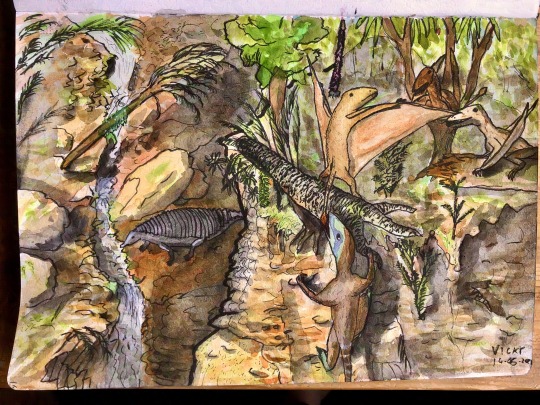
A Peteinosaurus shows off on a Williamsonia atop a small overgrown cliff, unaware of the Procompsognathus climbing the cliff to sneak up on him. Behind and below them, a Paratypothorax has come to her favourite stream to drink.
#peteinosaurus#procompsognathus#paratypothorax#pterosaur#dinosaur#coelophysid#theropod#aetosaur#pseudosuchian#triassic#paleoart#williamsonia#my art#palaeoblr#watercolour#cliffs#mountains
134 notes
·
View notes
Text
Turnersuchus: First of the Sea Crocs
A big find for crocodile finds was revealed two days ago. Turnersuchus hingleyae (Hingley's and Turner's crocodile) is the oldest described and basalmost thalattosuchian described so far and is of great importance to slowly figuring out where thalattosuchians come from.
But lets start with a brief introduction to thalattosuchians. As the name already suggests, thalattosuchians are primarily known to have been marine animals (tho exceptions are known). thalattosuchians can broadly be split into two groups. The teleosauroids, which look somewhat similar to what one might call a normal crocodile, and the metriorhynchoids, which especially in the derived members could aptly be described as crocodile mermaids.
Below an example of each, on the left Macrospondylus by Nikolay Zverkov and on the right a generalized metriorhynchid by Gabriel Ugueto.

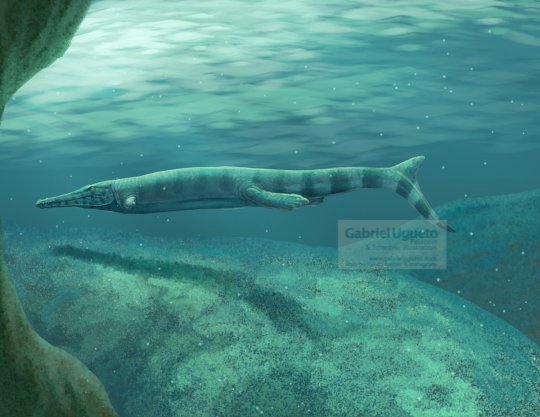
Thalattosuchians such as these two groups, which are sister clades and not successive lineages (so they co-occured rather than one having evolved from the other), were incredibly successful during the Jurassic, evolving enormous forms such as Plesiosuchus, Dakosaurus and Machimosaurus. Their wild success held on throughout the Jurassic until they eventually went extinct in the early Cretaceous. But despite how common and whidespread they are, we don't actually have much of a clue where they come from. Thalattosuchians just kinda appear during the Toarcian and are already found across multiple continents with both groups established. To complicate matters, their position among crocodiles is also rather shaky. Three main hypothesis exist. One is that they are a sister group to crocodyliforms (Protosuchians, Notosuchians and Neosuchians), that they are basal mesoeucrocodylians or that they are Neosuchians related to Pholidosaurids (like Sarcosuchus) and Dyrosaurs.
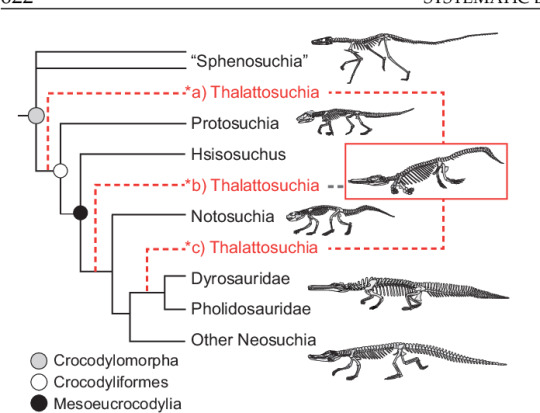
This is where Turnersuchus comes in. Discovered in the Charmouth Mudstone Formation of Dorset, England, this genus is known from the skeletal material belonging to the back of the head, mandible, parts of the forearms and shoulder girdle as well as neck, body and tail vertebrae all preserved in five blocks and a few isolated pieces of bone. From that we can already see general similarities to derived thalattosuchians and basic traits like narrow jaws and reduced forelimbs (tho not nearly as extreme as in metriorhynchids).
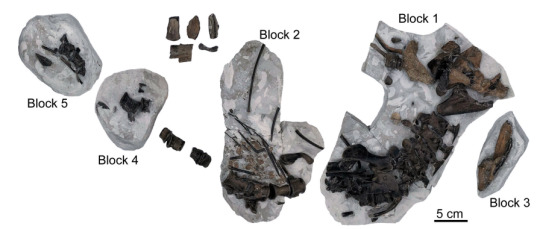
The first significant part about this discovery is its age. Turnersuchus is from the Pliensbachian stage of the Jurassic, so it predates any previously diagnostic thalattosuchians. Secondly is its position. As I said above, thalattosuchians are divided into teleosauroids and metriorhynchoids. But Turnersuchus is neither, with both phylogenetic analysis finding it to fall outside of these groups. Now in fairness this is not rock solid, as there is only a single trait excluding it from the derived groups in either analysis, so future works might shake things up. But as things are right now, it's the oldest named and basalmost member of the entire clade. On a sidenote at least the oldest part is bound to change, as the paper mentions a Moroccon teleosauroid currently in press that is even older.
All of this allows for two things. For one, by comparing Turnersuchus with the basal members of both teleosauroids and metriorhynchoids scientists were able to gather a list of traits that appear to be ancestral to the group. In addition, Turnersuchus also preserves some features that separate it from all other thalattosuchians that are also indicative of being an early member. Just as one example a specific part of the basioccipital thats associated with long skulls is poorly developed, which means that while slender the jaws weren't as long as in some later thalattosuchians. A Bayesian analysis was also conducted in an attempt to nail down when thalattosuchians evolved. Now depending on which phylogeny is used (one with thalattosuchians as non-crocodyliforms and another with them as mesoeucrocodylians) you get different times. The former would place their origin in the Norian stage of the Triassic, the later in the Sinemurian stage of the Jurassic. In light of the Moroccon material alluded to by the paper, it would appear that they likely split from other crocodylomorphs sometime in the late Triassic.
And finally to wrap this up let me share the press release artwork to finally give a face to all this information. Now if you've read my post about fossil crocs of 2022 you might already recognize the artist, as she's been on a real streak with illustrating fossil crocs. If you don't know her, I highly recommend checking out her work. I'm of course talking about Júlia d'Oliveira.

And yes, of course I got the Wikipedia page for it ready. Tho with work getting in the way when it was published I almost feared I'd be unable to get to it first.
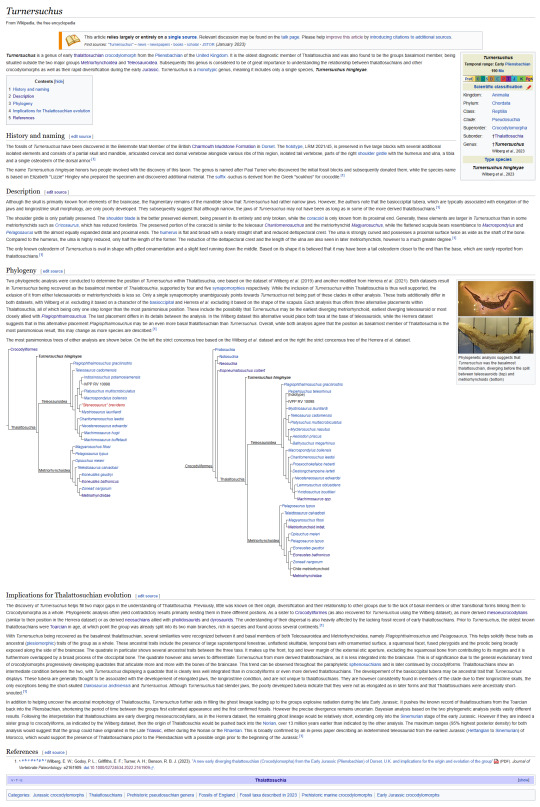
#turnersuchus#thalattosuchia#metriorhynchidae#teleosauridae#jurassic#paleontology#palaeblr#crocodylomorph#croc#pseudosuchian#marine reptile#long post#Wikipedia#paleontology news#crocodile
117 notes
·
View notes